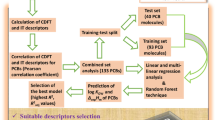Abstract
A Quantitative Structure–Property Relationship (QSPR) study based on artificial neural network (ANN) was carried out for the prediction of the gas-to-wet butyl acetate partition coefficient of a set of 81 organic compounds of very different chemical nature. The genetic algorithm-partial least squares (GA-PLS) method was applied as a variable selection tool. A PLS method was used to select the best descriptors and the selected descriptors were used as input neurons in neural network model. These descriptors are: Randic index (order 2) (2χ), atomic charge weighted partial positively charged surface area (PPSA-3), difference between atomic charge weighted partial positive and negative surface areas (DPSA-3), minimum net atomic charge for a O atom (q min O) and hydrogen bonding donor ability of the molecule (HDSA1). The results obtained showed the ability of developed ANN for prediction of the gas-to-wet butyl acetate partition coefficients of various compounds. Also result reveals the superiority of the ANN over the PLS model.




Similar content being viewed by others
References
Sato A, Nakajima T (1979) Toxicol Appl Pharmacol 47:41
Gargas ML, Burgess RJ, Voisard DE, Cason GH, Andersen ME (1989) Toxicol Appl Pharmacol 98:87
Lu W, Chen Y, Liu M, Chen X, Hu Z (2007) Chemosphere 69:469
Toropov AA, Roy KJ (2004) Chem Inf Comput Sci 44:179
Katritzky AR, Kuanar M, Fara DC, Karelson M, Acree W E Jr (2004) Bioorg Med Chem 12:4735
Luan F, Liu HT, Ma WP, Fan BT (2008) Ecotoxicol Environ Safe 71:731
Chen J, Xue X, Schramm KW, Quan X, Yang F, Kettrup A (2002) Chemosphere 8:535
Zhang Q, Huang J, Yu G (2008) Prog Nat Sci 18:867
Fatemi MH, Karimian FJ (2007) Colloid Interface Sci 314:665
Vegas V, Zufiria PJ (2004) Neural Netw 17:233
Schweitzer RC, Morris JB (1999) Anal Chem Acta 384:285
Tong CS, Cheng KC (1999) Chemom Intell Lab Syst 49:135
Lui F, Liang Y, Cao C (2006) Chemom Intell Lab Syst 81:120
Golmohammadi H, Fatemi MH (2005) Electrophoresis 26:3438
Baher E, Fatemi MH, Konoz E, Golmohammadi H (2007) Microchim Acta 158:117
Konoz E, Golmohammadi H (2008) Anal Chim Acta 619:157
Golmohammadi HJ (2009) Comput Chem 30:2455
Dashtbozorgi Z, Golmohammadi H (2010) Eur J Med Chem 45:2182
Golmohammadi H, Safdari M (2010) Microchem J 95:140
Sprunger LM, Proctor A, Acree W E Jr, Abraham MH, Dakhamab NB (2008) Fluid Phase Equilib 270:30
Katritzky AR, Lobanov VS, Karelson M (1994) Comprehensive descriptors for structural and statistical analysis. Version 1.1, Reference manual. University of Florida, Gainesville
Katritzky AR, Lobabanov VS, Karelson M (1995) Chem Soc Rev 24:279
Katritzky AR, Lobabanov VS, Karelson M (1997) Pure Appl Chem 69:245
Autodesk Inc. (1995) Hyperchem, re. 4 for Windows. Autodesk Inc., Sansalito
Stewart JJP (1990) Semiempirical molecular orbital program. QCPE 445 (1983), Version 6
Leardi R, Gonzales AL (1998) Chemom Intell Lab Syst 41:195
Goldberg DE (1989) Genetic algorithms in search. Optimization and machine learning. Addison-Wesley, New York
Kowalski B, Gerlach R, Joreskog KG, Wold H (eds) (1982) Systems under indirect observation. North Holland, Amsterdam
Yu R-Q (1992) Introduction to chemometrics. Human Education Publishing House, Changsha
Dayal BS, MacGregor JFJ (1997) Chemometrics 11:73
Geladi P, Kowalski BR (1986) Anal Chim Acta 185:1
Lorber A, Wangen L, Kowalsky BRJ (1987) Chemometrics 1:19
Khayamian T, Ensafi AA, Hemmateenejad B (1999) Talanta 49:587
Shamsipur M, Hemmateenejad B, Akhond M, Sharghi H (2001) Talanta 54:1113
Hoskuldsson A (2001) Chemom Intell Lab Syst 55:23
MATLAB 7.0. The Mathworks Inc., Natick. http://www.mathworks.com
Bishop CM (1995) Neural networks for pattern recognition. Clarendon Press, Oxford
Rumelhart DE, Hinton GE, Williams RJ (1996) Learning internal representation by error propagation. Parallel distributed processing: explorations in the microstructure of cognition, vol 1. The MIT Press, Cambridge
Blank TB, Brown ST (1993) Anal Chem 65:3081
Jalali-Heravi M, Fatemi MHJ (2001) Chromatogr A 915:177
Golbraikh A, Tropsha AJ (2002) Mol Graphics Model 20:269
Roy PP, Roy K (2008) QSAR Comb Sci 27:302
Maldonado AG, Doucet JP, Petitjean M, Fan BT (2006) Mol Divers 10:39
Kier LB, Hall LH (1976) Molecular connectivity in chemistry and drug research. Academic Press, New York
Kier LB, Hall H (1986) Molecular connectivity in structure-activity analysis. Wiley, New York
El-Basil S, Randic M (1992) Adv Quant Chem 24:239
Stankevich MI, Stankevich IV, Zefirov NS (1088) Russ Chem Rev 57:191
Zefirov NS, Kirpichenok MA, Izmailov FF, Trofimov MI (1987) Dokl Akad Nauk SSSR 296:883
Kirpichenok MA, Zefirov NS (1987) Zh Org Khim 23:4
Stanton DT, Jurs PC (1990) Anal Chem 62:2323
Stanton DT, Egolf LM, Jurs PC, Hicks MGJ (1992) Chem Inf Comput Sci 32:306
Author information
Authors and Affiliations
Corresponding author
Rights and permissions
About this article
Cite this article
Golmohammadi, H., Dashtbozorgi, Z. Quantitative structure–property relationship studies of gas-to-wet butyl acetate partition coefficient of some organic compounds using genetic algorithm and artificial neural network. Struct Chem 21, 1241–1252 (2010). https://doi.org/10.1007/s11224-010-9669-8
Received:
Accepted:
Published:
Issue Date:
DOI: https://doi.org/10.1007/s11224-010-9669-8




